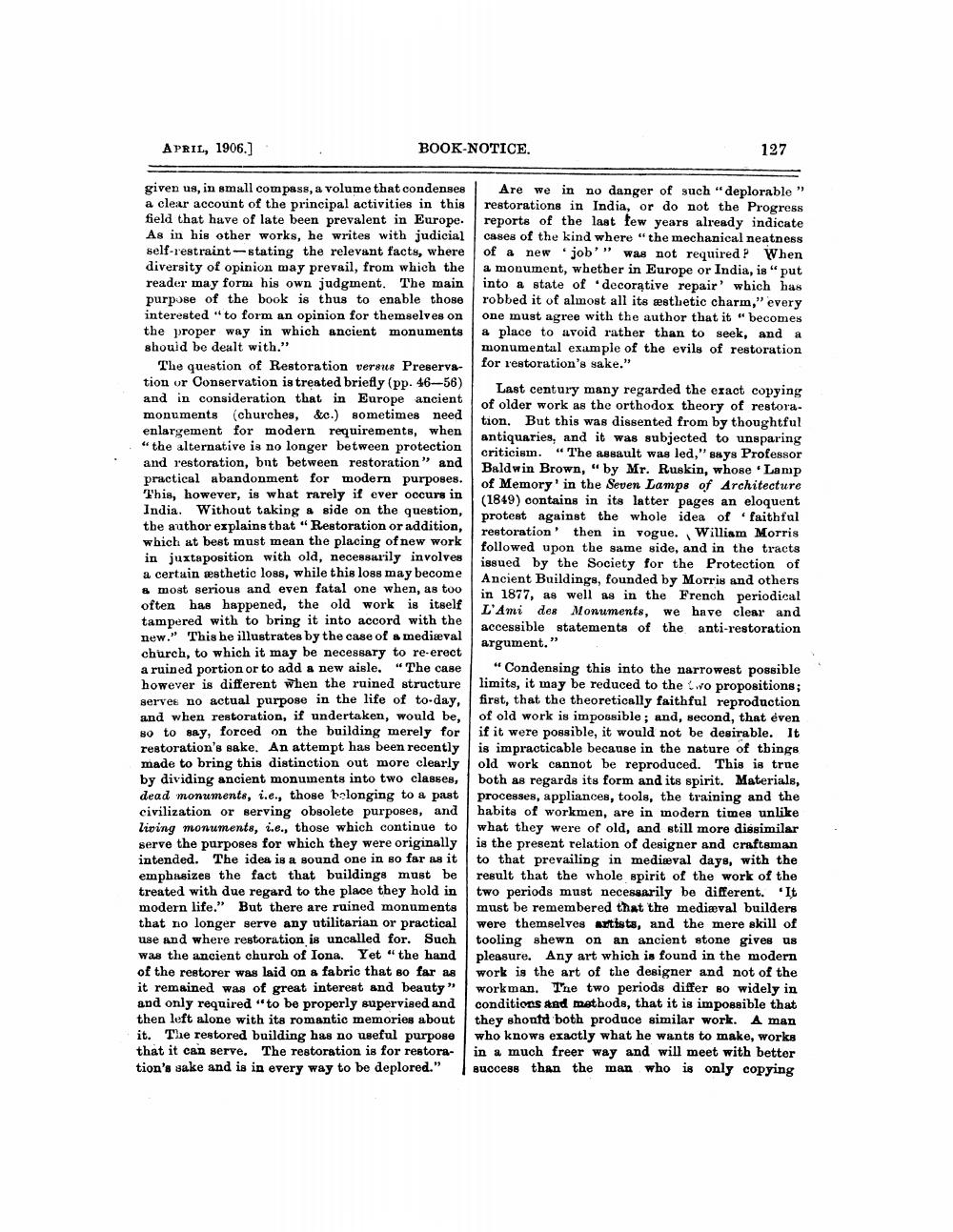________________
APRIL, 1906.]
BOOK-NOTICE.
127
given us, in small compass, a volume that condenses Are we in no danger of such "deplorable" a clear account of the principal activities in this restorations in India, or do not the Progress field that have of late been prevalent in Europe. reports of the last few years already indicate As in his other works, he writes with judicial cases of the kind where "the mechanical neatness self-restraint-stating the relevant facts, where of a new job'" was not required P When diversity of opinion may prevail, from which the a monument, whether in Europe or India, is "put reader may form his own judgment. The main into a state of decorative repair' which has purpose of the book is thus to enable those robbed it of almost all its aesthetic charm,"every interested to form an opinion for themselves on one must agree with the author that it becomes the proper way in which ancient monuments & place to avoid rather than to seek, and a should be dealt with."
monumental example of the evils of restoration The question of Restoration versus Preserva- for restoration's sake." tion or Conservation is treated briefly (pp. 46-56)
Last century many regarded the exact copying and in consideration that in Europe ancient
of older work as the orthodox theory of restora. monuments (churches, &c.) sometimes need
tion. But this was dissented from by thoughtful enlargement for modern requirements, when
antiquaries, and it was subjected to unsparing “the alternative is no longer between protection
criticism. "The assault was led," says Professor and restoration, but between restoration” and
Baldwin Brown, "by Mr. Ruskin, whose Lamp practical abandonment for modern purposes.
of Memory' in the Seven Lamps of Architecture This, however, is what rarely if ever occurs in
(1849) contains in its latter pages an eloquent India. Without taking a side on the question,
protest against the whole idea of faithful the author explains that "Restoration or addition,
restoration' then in vogue. William Morris which at best must mean the placing of new work
followed upon the same side, and in the tracts in juxtaposition with old, necessarily involves
issued by the Society for the Protection of a certain westhetic loss, while this loss may become
Ancient Buildings, founded by Morris and others & most serious and even fatal one when, as too
in 1877, as well as in the French periodical often bas happened, the old work is itself
L'Ami des Monuments, we have clear and tampered with to bring it into accord with the
accessible statements of the anti-restoration new." This be illustrates by the case of a medieval
argument." church, to which it may be necessary to re-erect a ruined portion or to add a new aisle. "The case "Condensing this into the narrowest possible however is different when the ruined structure limits, it may be reduced to the two propositions; serves no actual purpose in the life of to-day, first, that the theoretically faithful reproduction and when restoration, if undertaken, would be, of old work is impossible: and, second, that even 80 to say, forced on the building merely for if it were possible, it would not be desirable. It restoration's sake. An attempt has been recently is impracticable because in the nature of tbinge made to bring this distinction out more clearly old work cannot be reproduced. This is true by dividing ancient monuments into two classes, 1 both as regards its form and its spirit. Materials, dead monuments, i.e., those belonging to a past processes, appliances, tools, the training and the civilization or serving obsolete purposes, and habits of workmen, are in modern times unlike living monuments, i.e., those which continue to what they were of old, and still more dissimilar serve the purposes for which they were originally is the present relation of designer and craftsman intended. The idea is a sound one in so far as it to that prevailing in mediæval days, with the emphasizes the fact that buildings must be result that the whole spirit of the work of the treated with due regard to the place they hold in two periods must necessarily be different. It modern life." But there are ruined monuments must be remembered that the mediaval builders that no longer serve any utilitarian or practical were themselves artists, and the mere skill of use and where restoration is uncalled for. Such tooling shewn on an ancient stone gives us was the ancient church of Iona. Yet "the hand pleasure. Any art which is found in the modern of the restorer was laid on a fabric that so far as work is the art of the designer and not of the it remained was of great interest and beauty" workman. The two periods differ so widely in and only required to be properly supervised and conditions and methods, that it is impossible that then left alone with its romantic memories about they should both produce similar work. A man it. The restored building has no useful purpose who knows exactly what he wants to make, works that it can serve. The restoration is for restora- in a much freer way and will meet with better tion's sake and is in every way to be deplored." success than the man who is only copying




